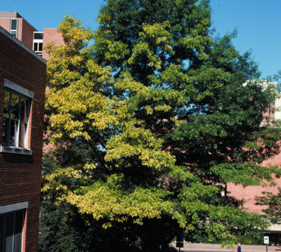
What is chlorosis?
Chlorosis is a common nutritional disorder of many woody ornamentals in Wisconsin, particularly in the southern and eastern parts of the state. Pin oaks are most commonly affected by chlorosis, although many other trees and shrubs (e.g., white oaks, red maples, white pines and rhododendrons) are also very susceptible.
What does chlorosis look like?
Symptoms of chlorosis are easy to distinguish from those of other diseases. Affected leaves turn yellow, except for the veins, which remain green. In severe cases, foliage may turn brown and die. Symptoms can occur on isolated branches, or over an entire tree.
What causes chlorosis?
Chlorosis occurs when a tree or shrub is lacking certain micronutrients, in many cases iron or manganese. Lack of micronutrients in a tree may reflect a lack of these nutrients in the soil due to poor fertility. Often however, there are sufficient micronutrients, but they cannot be absorbed by a plant’s roots. Poor absorption of micronutrients is common in Wisconsin because of the high pH (alkalinity) of many soils.
How do I save a tree or shrub with chlorosis?
Chlorosis is rarely fatal and can be treated. For treatments to be effective, you must determine the exact cause of the chlorosis. Have the soil around an affected plant tested for micronutrients and for pH prior to applying any treatment. If the soil test indicates a lack of specific micronutrients, fertilize with these micronutrients. For example, chelated iron compounds can be used to increase the amount of iron in soil. If the soil test indicates a high soil pH, lower the pH by applying sulfur or ammonium sulfate. See University of Wisconsin Garden Facts XHT1151, Reducing Soil pH, for details. Contact your county Extension agent for information on soil testing and for tips on a treatment once you have determined the specific cause of your chlorosis problem.
How do I avoid problems with chlorosis in the future?
Plant trees and shrubs that are less susceptible to chlorosis. Also, make sure your trees and shrubs receive sufficient water (approximately one inch per week), as this will help plants with micronutrient uptake. During dry periods, use a drip hose or soaker hose to apply supplemental water. Remove turf from around the bases of trees and shrubs out to at least the drip lines, and apply shredded hardwood, pine or cedar mulch in these areas to help maintain soil moisture. On heavy clay soils, use one to two inches of mulch. On other soils, use three to four inches of mulch. Be sure to keep mulch four inches from the trunks of trees. If you decide to plant susceptible trees or shrubs, watch them closely for the yellowing characteristic of chlorosis, and apply corrective treatments as soon as symptoms appear. Treatments should always be based on the results of soil micronutrient and pH tests.
For more information on chlorosis:
Contact the University of Wisconsin Plant Disease Diagnostics Clinic (PDDC) at (608) 262-2863 or pddc@wisc.edu.
Additional Images
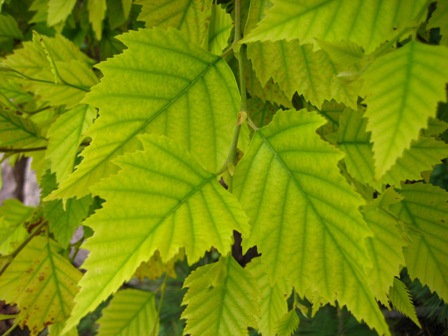

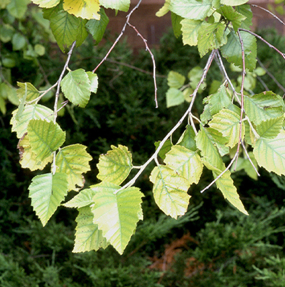
Authors: Brian Hudelson, UW-Madison Plant Pathology
Last Revised: 02/29/2024
D-number: D0030
References to pesticide products in this publication are for your convenience and are not an endorsement or criticism of one product over similar products. You are responsible for using pesticides according to the manufacturer’s current label directions. Follow directions exactly to protect the environment and people from pesticide exposure. Failure to do so violates the law.
Thanks to Sharon Morrisey, Patti Nagai and Ann Wied for reviewing this document.
A complete inventory of UW Plant Disease Facts is available at the University of Wisconsin-Madison Plant Disease Diagnostics Clinic website: https://pddc.wisc.edu.
Send a Plant Sample for Analysis
Be cautious when self-diagnosing plant health issues. Very few diseases can accurately be diagnosed by eye.
Contact the UW Plant Disease Diagnostics Clinic (PDDC), and for a small fee, clinic staff can examine a plant, determine the cause of the disease/disorder, and provide advice on how to control or prevent the issue.
Download Article





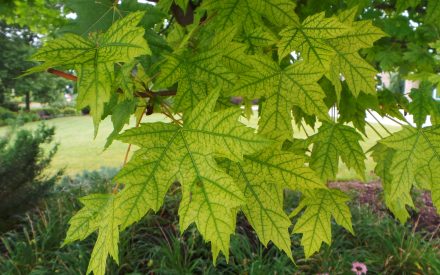 Reducing Soil pH
Reducing Soil pH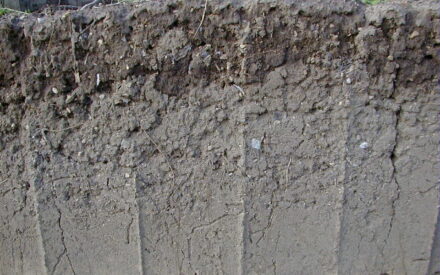 Sampling Garden Soils and Turf Areas for Testing
Sampling Garden Soils and Turf Areas for Testing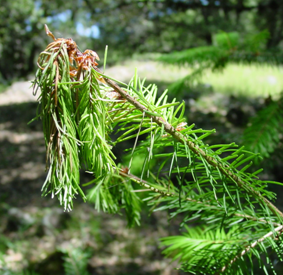 Sudden Oak Death
Sudden Oak Death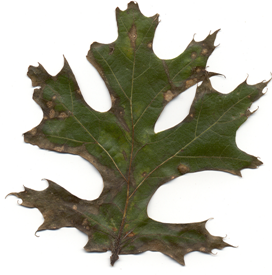 Tubakia (Actinopelte) Leaf Spot
Tubakia (Actinopelte) Leaf Spot


